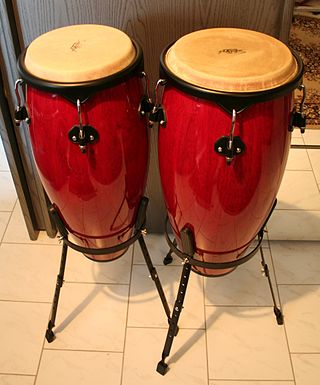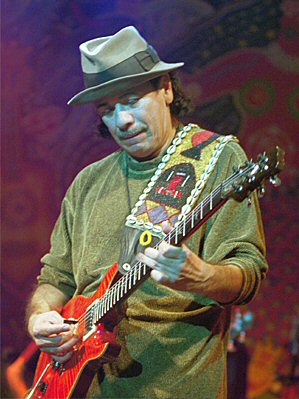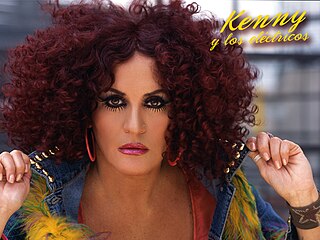The music of Latin America refers to music originating from Latin America, namely the Romance-speaking regions of the Americas south of the United States. Latin American music also incorporate the Indigenous peoples of the Americas. Due to its highly syncretic nature, Latin American music encompasses a wide variety of styles, including influential genres such as cumbia, bachata, bossa nova, merengue, rumba, salsa, samba, son, and tango. During the 20th century, many styles were influenced by the music of the United States giving rise to genres such as Latin pop, rock, jazz, hip hop, and reggaeton.

Salsa music is a style of Latin American music, combining elements of Cuban, Puerto Rican, and American influences. Because most of the basic musical components predate the labeling of salsa, there have been many controversies regarding its origin. Most songs considered as salsa are primarily based on Son montuno, with elements of Guaracha, Cha cha cha, Guaguancó, Danzón, Bolero, Changüí, Charanga, Columbia, Guajira, Songo, Timba, Pachanga, Tumbao, Rumba, Yambú, mambo, Latin jazz, bomba and plena. All of these elements are adapted to fit the basic Son montuno template when performed within the context of salsa.

Tejano music, also known as Tex-Mex music, is a popular music style fusing Mexican and US influences. Typically, Tejano combines Mexican Spanish vocal styles with dance rhythms from Czech and German genres – particularly polka or waltz. Tejano music is traditionally played by small groups featuring accordion and guitar or bajo sexto. Its evolution began in northern Mexico.

Chicano rock, also called chicano fusion, is rock music performed by Mexican American (Chicano) groups or music with themes derived from Chicano culture. Chicano Rock, to a great extent, does not refer to any single style or approach. Some of these groups do not sing in Spanish at all, or use many specific Latin instruments or sounds. The subgenre is defined by the ethnicity of its performers, and as a result covers a wide range of approaches.
Bolero is a genre of song which originated in eastern Cuba in the late 19th century as part of the trova tradition. Unrelated to the older Spanish dance of the same name, bolero is characterized by sophisticated lyrics dealing with love. It has been called the "quintessential Latin American romantic song of the twentieth century".

Norteño or Norteña, also música norteña, is a genre of regional Mexican music. The music is most often based on duple and triple metre and its lyrics often deal with socially relevant topics, although there are also many norteño love songs. The accordion and the bajo sexto are traditional norteño's most characteristic instruments. Norteña music developed in the late 19th century, as a mixture between local Mexican music and Austrian-Czech-origin folk music.
The folkloric traditional music of Paraguay is the Paraguayan polka and the Guarania. The Paraguayan polka comes from polka of Czech origin; that was danced for the first time in Asunción, on November 27, 1858. The guarania was created by the Paraguayan musician José Asunción Flores, in January 1925, after experiencing different arrangements with the old Paraguayan musical theme "Ma'erãpa reikuaase". Paraguay also has classical music and popular music consisting of rock and jazz music. The folk music uses a range of different instruments some of which include the Spanish guitar and the European harp.

El Gran Silencio is a rock en español band from Monterrey, Mexico that blends a variety of rock, reggae, dancehall, and hip-hop influences with traditional Latin American musical forms such as cumbia, vallenato and Norteño. Their lyrics tend to be bohemian and often talk about life in the “barrio” or poor neighborhoods of Mexican cities, especially Monterrey. As of 2015, they have recorded seven albums, eleven singles, six soundtracks, five tributes and seventeen collaborations and have toured Mexico and the United States.

Mexican rock music, often referred to in Mexico as rock nacional, originated in the 1950s. Standards by The Beatles, Elvis Presley, The Everly Brothers, Nancy Sinatra, and Chuck Berry were soon covered by bands such as Los Apson, Los Teen Tops, Los Twisters, Los Hitters, Los Nómadas, Los Rockets, Los Rebeldes del Rock, Los Locos del Ritmo, Los Crazy Boys, and Javier Bátiz, which later led to original compositions, often in English. The group "Los Nómadas" was the first racially integrated band of the 1950s. Their lead guitarist, Bill Aken, wrote most of their original material, including the raucous Donde-Donde, and co-wrote the material for their Sounds Of The Barrio album, which is still being sold. Their 1954 recording of She's My Babe was the first top 40 R&B recording by a Latino band. In the southwestern United States, Spanish guitar rhythms and Mexican musical influences may have inspired some of the music of American musicians Ritchie Valens, Danny Flores, Sam the Sham, Roy Orbison, and later, Herb Alpert. Initially, the public exhibited only moderate interest in them, because the media attention was focused on La Ola Inglesa.
Ruben and the Jets was an American rock and roll band from Los Angeles, California. The band originated as an alias for The Mothers of Invention, Frank Zappa's band, to release Cruising with Ruben & the Jets (1968). Later, musician Rubén Guevara Jr. continued the band with his own lineup. Guevara's "Jets" recorded two albums, For Real! (1973) and Con Safos (1974).

Rock en español is a term used to refer to any kind of rock music featuring Spanish vocals. Compared to English-speaking bands, very few acts reached worldwide success or between Spanish-speaking countries due to a lack of promotion. Despite rock en español's origins in the late 1950s, many rock acts achieved at best nationwide fame until the Internet consolidated the listeners. However, some rock en español artists did become internationally popular with the help of a promotional campaign from the mid-1980s to the mid-1990s called "Rock en tu idioma". Some specific rock-based styles influenced by folkloric rhythms have also developed in these regions. Some of the more prominent styles are Latin rock ; Latin alternative, an alternative rock scene that blended a Latin sound with other genres like Caribbean ska, reggae, and soca; or Andalusian rock, a flamenco-influenced style that emerged in Spain.
Latino punk is punk music created by Latino people in Latin America and the United States. The angst and protest qualities of punk music and style have had a strong appeal to Latino youth in the U.S., and to the people in Latin America. It is impossible to pinpoint the exact location or moment when Latinos began engaging in the punk subculture. However, Latin American rock began showing aspects of punk music during the mid-1960s with the Peruvian band Los Saicos; this band reflected many aspects of other proto-punk bands such as the Yardbirds. The Saicos were predecessors to some of the most influential proto-punk bands in the U.S., such as New York Dolls, MC5, and The Stooges

Brown-eyed soul, also referred to as Chicano soul, is soul music performed in the United States mainly by Hispanic Latinos and Chicanos in Southern California, East Los Angeles, and San Antonio (Texas) during the 1960s, continuing through to the early 1980s. The trend of Latinos started with Latino rock and roll and rock musicians. "Brown eyed soul" contrasts with blue-eyed soul, soul music performed by non-Hispanic white artists.

Natiruts is a Brazilian reggae band from Brasília. Formed in 1996, Natiruts has released six studio albums and five live albums during a career spanning three decades. The group released its debut album Nativus in 1997 and increased in popularity through its 2009 album Raçaman and the accompanying single "Sorri, Sou Rei". The group's 2012 album Acústico was nominated for Best Brazilian Contemporary Pop Album at the 2013 Latin Grammy Awards.
Latin alternative, or "alterlatino", is a brand of Latin rock music produced by combining genres like alternative rock, lofi, chillout, metal, electronica, hip hop, new wave, pop rock, punk rock, reggae, and ska with traditional Ibero-American sounds, in Latin Europeans and Latin Americans countries.

Lo Essential de Maná is a three CD box set of the first three studio albums under recording label WEA Latina from Mexican rock band Maná. Since they burst on the scene from Guadalajara, Mexico, in the early 1990s, Maná have reigned as the premier Latin rock band of our time. Led by the powerful and passionate vocalist-composer Fher Olvera, drummer Alex González, guitarist Sergio Vallín, and bassist Juan Diego Calleros blend American power rock with Hispanic folk idioms and Afro-Caribbean rhythms. This three-CD box set compilation contains the band's greatest hits, from their début album, Falta Amorto their third album Cuando Los Ángeles Lloran. A total of 37 songs from their favorites appear, including "Vivir Sin Aire," "Dónde Jugarán los Niños?", and the reggae-tinged "Selva Negra." Other favorites, such as "La Chula" and "Como Te Deseo," are remixed as pop-dance numbers.

Fogaraté! is the seventh album of the famous Dominican songwriter and musician Juan Luis Guerra. It was released on July 19, 1994. The album mixed a variety of music genres including rural and flolklroic rots of merengue called "Perico Ripao" with elements of African soukus music and Tropical Music such as Reggae with the collaboration of African guitarist Diblo Dibala and Dominican accordionist Francisco Ulloa, along with Son, Bachata and Salsa. Also, the album features a particular, bachata-styled adaptation of the Lacrimosa movement from Mozart's Requiem Mass in D Minor and Guerra's first song fully in English "July 19". Exploring lyrics and themes about magical realism of Latin American literature and commenting on the politics of the Caribbean, for many fans and critics, Fogaraté! is one of his most musically complex album.

Latin music is a term used by the music industry as a catch-all category for various styles of music from Ibero-America, which encompasses Latin America, Spain, Portugal, and the Latino community in Canada and the United States, as well as music that is sung in either Spanish and/or Portuguese.

Kenny y los Eléctricos is a rock band founded in 1980 by the singer and band leader Kenny Aviles, who has been called "the mother of Mexican rock". The band started in Los Angeles, where they made their first public appearances under the name Kenny and The Electrics, playing in venues like Whisky a Go Go. They moved back to Mexico in 1980 and went on to be considered an internationally important Mexican rock band, emblematic of Mexican rock in the 1980s.
This article includes an overview of trends in Latin music in the 1990s, namely in Ibero-America. This includes the rise and fall of various subgenres in Latin music from 1990 to 1999.















